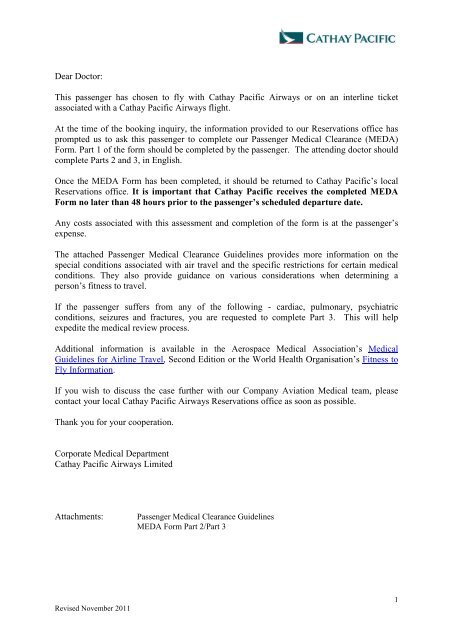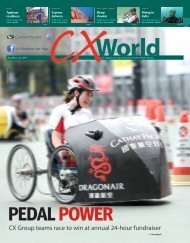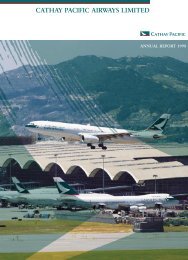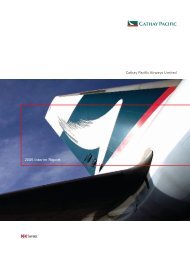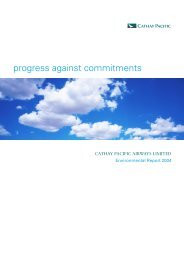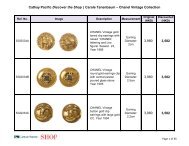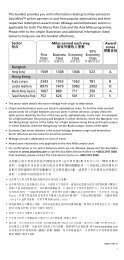Dear Doctor: This passenger has chosen to fly with Cathay Pacific ...
Dear Doctor: This passenger has chosen to fly with Cathay Pacific ...
Dear Doctor: This passenger has chosen to fly with Cathay Pacific ...
Create successful ePaper yourself
Turn your PDF publications into a flip-book with our unique Google optimized e-Paper software.
<strong>Dear</strong> <strong>Doc<strong>to</strong>r</strong>:<br />
<strong>This</strong> <strong>passenger</strong> <strong>has</strong> <strong>chosen</strong> <strong>to</strong> <strong>fly</strong> <strong>with</strong> <strong>Cathay</strong> <strong>Pacific</strong> Airways or on an interline ticket<br />
associated <strong>with</strong> a <strong>Cathay</strong> <strong>Pacific</strong> Airways flight.<br />
At the time of the booking inquiry, the information provided <strong>to</strong> our Reservations office <strong>has</strong><br />
prompted us <strong>to</strong> ask this <strong>passenger</strong> <strong>to</strong> complete our Passenger Medical Clearance (MEDA)<br />
Form. Part 1 of the form should be completed by the <strong>passenger</strong>. The attending doc<strong>to</strong>r should<br />
complete Parts 2 and 3, in English.<br />
Once the MEDA Form <strong>has</strong> been completed, it should be returned <strong>to</strong> <strong>Cathay</strong> <strong>Pacific</strong>’s local<br />
Reservations office. It is important that <strong>Cathay</strong> <strong>Pacific</strong> receives the completed MEDA<br />
Form no later than 48 hours prior <strong>to</strong> the <strong>passenger</strong>’s scheduled departure date.<br />
Any costs associated <strong>with</strong> this assessment and completion of the form is at the <strong>passenger</strong>’s<br />
expense.<br />
The attached Passenger Medical Clearance Guidelines provides more information on the<br />
special conditions associated <strong>with</strong> air travel and the specific restrictions for certain medical<br />
conditions. They also provide guidance on various considerations when determining a<br />
person’s fitness <strong>to</strong> travel.<br />
If the <strong>passenger</strong> suffers from any of the following - cardiac, pulmonary, psychiatric<br />
conditions, seizures and fractures, you are requested <strong>to</strong> complete Part 3. <strong>This</strong> will help<br />
expedite the medical review process.<br />
Additional information is available in the Aerospace Medical Association’s Medical<br />
Guidelines for Airline Travel, Second Edition or the World Health Organisation’s Fitness <strong>to</strong><br />
Fly Information.<br />
If you wish <strong>to</strong> discuss the case further <strong>with</strong> our Company Aviation Medical team, please<br />
contact your local <strong>Cathay</strong> <strong>Pacific</strong> Airways Reservations office as soon as possible.<br />
Thank you for your cooperation.<br />
Corporate Medical Department<br />
<strong>Cathay</strong> <strong>Pacific</strong> Airways Limited<br />
Attachments: Passenger Medical Clearance Guidelines<br />
MEDA Form Part 2/Part 3<br />
Revised November 2011<br />
1
Revised November 2011<br />
Passenger Medical Clearance Guidelines<br />
Air travel <strong>has</strong> some unique features which must be considered by <strong>passenger</strong>s <strong>with</strong> medical conditions and<br />
their treating doc<strong>to</strong>rs <strong>to</strong> ensure a safe and comfortable flight.<br />
The principle fac<strong>to</strong>rs <strong>to</strong> consider when assessing a <strong>passenger</strong>’s fitness for air travel are:<br />
• Reduced atmospheric pressure: Cabin air pressure changes occur after take-off and before<br />
landing and lead <strong>to</strong> gas expansion and contraction which may cause pain and pressure effects.<br />
• Reduction in oxygen tension: The aircraft cabin is pressurised <strong>to</strong> an equivalent of 6,000-8,000<br />
feet and oxygen partial pressure is approximately 20% less than on ground. Healthy <strong>passenger</strong>s<br />
have no problems at these altitudes, but <strong>passenger</strong>s <strong>with</strong> anaemia or heart and lung conditions may<br />
be at risk and require supplemental oxygen during air travel.<br />
• Inaccessibility <strong>to</strong> advanced medical care: The aircraft cabin is a closed environment where access<br />
<strong>to</strong> advanced medical care may not be possible for several hours. Our cabin crew is trained in basic<br />
first aid and we do carry medical kits and heart defibrilla<strong>to</strong>rs on board, but advanced medical care<br />
onboard is not possible. If a <strong>passenger</strong> <strong>has</strong> a medical condition that carry a high risk of requiring<br />
extraordinary medical assistance in flight they may not be accepted for air travel.<br />
Specific Medical Conditions<br />
When calculating the number of days post-incident count the day of operation/onset of illness and day of travel.<br />
Diagnosis Not fit <strong>to</strong> <strong>fly</strong> Medical clearance required Comments<br />
Blood disorders<br />
Anaemia Hb < 7.5g/dl Hb 7.5 – 10 g/dl If acutely anaemic, Hb level should be assessed<br />
more than 24 hours after last blood loss, which<br />
must have ceased.<br />
Sickle cell disease < 10 days after Within 10 days of sickling crisis Accepted for travel 10 days after sickling crisis<br />
Sickling crisis<br />
if otherwise stable.<br />
Cardiovascular and other Circula<strong>to</strong>ry disorders<br />
Angina Unstable angina • Passengers <strong>with</strong> frequent chest pains<br />
should consult their doc<strong>to</strong>r regarding their<br />
fitness <strong>to</strong> travel.<br />
• Must be stable and no angina at rest.<br />
• Have sufficient medications at hand <strong>to</strong><br />
relief an angina attack.<br />
Myocardial infarction Within 7 days All 6 weeks post-MI • Any cardiac failure?<br />
• Any Arrhythmia?<br />
• Any post-MI angina pain?<br />
• Is the heart size larger than normal?<br />
• Any pre-attack angina?<br />
If NO: Uncomplicated; may travel after 7 days.<br />
If YES: Complicated. Disposition depends on<br />
individual assessment (stability, success of<br />
Cardiac Failure Uncontrolled heart<br />
failure<br />
stenting, escort proposed, etc.)<br />
If require inflight oxygen. • Passengers <strong>with</strong> uncontrolled heart failure<br />
should consult their doc<strong>to</strong>r regarding their<br />
fitness <strong>to</strong> travel.<br />
• Adequate control is someone that can walk<br />
50 meters (50yards) or go up a flight of<br />
stairs on room air at a normal pace <strong>with</strong>out<br />
breathlessness. Otherwise, inflight oxygen<br />
may need <strong>to</strong> be considered.<br />
2
Diagnosis Not fit <strong>to</strong> <strong>fly</strong> Medical clearance required Comments<br />
Angioplasty <strong>with</strong> or Within 3 days < 7 days Elective, uncomplicated cases may travel:<br />
<strong>with</strong>out Stenting<br />
• 3 days after angioplasty<br />
• 5 days after stenting.<br />
Open-chest Cardiac Within 10 days All require medical clearance May travel after 10 days if uncomplicated.<br />
Surgery<br />
during the 10 -21 days pos<strong>to</strong>perative<br />
period.<br />
Serious cardiac<br />
arrhythmia<br />
Within 7 days If < 21 days Does not include benign arrhythmias.<br />
Pulmonary Oedema Unresolved If < 21 days Pulmonary oedema and any precipitating<br />
condition should be resolved.<br />
Cyanotic congenital<br />
All cases Inflight oxygen needs <strong>to</strong> be considered in all<br />
heart disease<br />
cases.<br />
Angiography < 24 hours May travel after 24 hours if original condition<br />
is stable.<br />
Pacemaker insertion Within 2 days Within 7 days May travel after 2 days if:<br />
• no pneumothorax AND<br />
• rhythm is stable.<br />
Ablation therapy Within 2 days Within 7 days Passenger <strong>fly</strong>ing <strong>with</strong>in 1 week of the<br />
procedure is considered at high risk of DVT.<br />
Deep Vein<br />
If active Confirmed or suspected needs Stable on anticoagulants.<br />
Thrombosis (DVT)<br />
medical clearance.<br />
Pulmonary embolism Within 4 days of<br />
< 21 days May travel after 5 days if:<br />
onset<br />
• anticoagulation stable AND<br />
•<br />
Ear , Nose and Throat Conditions<br />
PAO2 normal on room air.<br />
Ear and sinus<br />
Acute illness or<br />
Must be able <strong>to</strong> clear ears <strong>with</strong> Valsalva<br />
infections<br />
loss of Eustachian<br />
tube function.<br />
maneuver.<br />
Middle ear surgery < 10 days 10 – 14 days after surgery • Allowed <strong>to</strong> <strong>fly</strong> 10 days after surgery.<br />
• Must be able <strong>to</strong> clear ears.<br />
Tonsillec<strong>to</strong>my < 7 days Only if complications Allowed <strong>to</strong> travel 7 days after surgery.<br />
Wired jaw If travelling alone If wired Must have:<br />
• escort <strong>with</strong> wire cutters OR<br />
• self quick release wiring.<br />
Corneal laser,<br />
Cataract surgery or<br />
other eye surgery<br />
< 24 hours<br />
Eye Conditions<br />
1-3 days Can travel after one day.<br />
Retinal Detachment<br />
Procedure<br />
< 10 days 1- 10 days after surgery Allowed <strong>to</strong> travel 10 days after the procedure.<br />
Penetrating eye injury < 7 days < 14 days Any gas in the globe must be reabsorbed.<br />
Gastrointestinal<br />
Bleeding<br />
Major Abdominal<br />
Surgery<br />
Revised November 2011<br />
Gastrointestinal Conditions<br />
< 24 hours after 1 <strong>to</strong> 10 days post-bleed. • Bleeding must have s<strong>to</strong>pped.<br />
bleed<br />
• Hemoglobin limits must be met.<br />
•<br />
•<br />
Risks of rebleeding must be assessed and<br />
be acceptable.<br />
< 10 days 1 <strong>to</strong> 10 days post op. • Accepted after 10 days if uncomplicated.<br />
• E.g. bowel resection, hysterec<strong>to</strong>my, renal,<br />
surgery, etc.<br />
3
Diagnosis Not fit <strong>to</strong> <strong>fly</strong> Medical clearance required Comments<br />
Appendec<strong>to</strong>my < 4 days Only if complicated Accepted after 4 days if uncomplicated.<br />
Laparoscopy<br />
(investigation)<br />
< 24 hours Accepted after 24 hours if all gas absorbed.<br />
Laparoscopic surgery < 4 days 1- 10 days post op<br />
Infectious Diseases<br />
All gas must be absorbed.<br />
E.g. cholecystec<strong>to</strong>my, tubal surgery<br />
Infectious diseases During contagious<br />
Must be non-infectious. See below for specific<br />
stage of illness<br />
diseases.<br />
Chicken pox If active lesions<br />
It is safe <strong>to</strong> travel when all exposed lesions are<br />
present<br />
dried and crusted.<br />
Tuberculosis All cases<br />
Neurological conditions<br />
Can travel if on medical treatment and medical<br />
documentation states that not infectious<br />
Epilepsy < 24 hours after fit If suffered from an epileptic fit Must be stable on medications.<br />
or unstable<br />
24 hours before flight.<br />
Stroke < 3days post-stroke Within 10 days • May travel after 10 days if uncomplicated.<br />
• Possibly may have <strong>to</strong> travel <strong>with</strong> an escort.<br />
Intracranial Surgery < 10 days post-op 10-21 days • Not <strong>with</strong>in 10 days of surgery.<br />
Orthopaedic Conditions<br />
• May only travel if cranium is free of air.<br />
Fractures < 48 hours if cast<br />
Splints/Casts must be bi-valved if travelling<br />
not bi-valved.<br />
<strong>with</strong>in 48 hours of injury or surgery on the<br />
fractures.<br />
Single pregnancy After 36 weeks<br />
Pregnancy and New born<br />
Any complications Clearance not required before 36 weeks unless<br />
(i.e. 35 weeks and<br />
complicated, but medical certificate needed<br />
6 days)<br />
after 28 weeks.<br />
Multiple pregnancy After 32 weeks Any complications Clearance not required before 32 weeks unless<br />
(i.e. 31 weeks and<br />
complicated, but medical certificate needed<br />
6 days)<br />
after 28 weeks.<br />
Miscarriage<br />
With active Within 7 days of bleeding Must be stable, no bleeding and no pain for at<br />
(threatened or<br />
complete)<br />
bleeding<br />
least 24 hours.<br />
New born < 48 hours Within 7 days of birth<br />
Psychiatric Conditions<br />
Fit and healthy babies can travel after 48 hours,<br />
but preferably after 7 days.<br />
Acute psychosis If unstable Within 14 days of unstable • Must be stable and appropriately escorted.<br />
episode or hospitalisation. • Escort may range from correctional<br />
officers, friends/relatives, <strong>to</strong> medically<br />
trained personnel <strong>with</strong> appropriate<br />
medications.<br />
• <strong>This</strong> is for safety reason.<br />
• Full psychiatric report required.<br />
Chronic psychiatric<br />
If significant risk of Travel may be approved <strong>with</strong> suitable medical<br />
disorders<br />
deterioration inflight<br />
Respira<strong>to</strong>ry Conditions<br />
escort / carer.<br />
Asthma < 48 hours after<br />
• Must be stable and carry appropriate<br />
severe attack<br />
medication onboard.<br />
• Please note “open circuit” nebulisers are<br />
not allowed <strong>to</strong> be used inflight.<br />
Chest surgery < 10 days < 28 days May travel after 10 days if uncomplicated<br />
recovery.<br />
Revised November 2011<br />
4
Diagnosis Not fit <strong>to</strong> <strong>fly</strong> Medical clearance required Comments<br />
Pneumothorax < 14 days after full<br />
inflation.<br />
Pneumonia Acute, <strong>with</strong><br />
symp<strong>to</strong>ms<br />
COPD, emphysema,<br />
pulmonary fibrosis,<br />
pleural effusion and<br />
haemothorax.<br />
Revised November 2011<br />
Cyanosis on the<br />
ground despite<br />
supplementary<br />
oxygen.<br />
Unresolved recent<br />
exacerbation.<br />
8-21 days after full inflation, if<br />
managed closed.<br />
If unstable or poor exercise<br />
<strong>to</strong>lerance.<br />
Within 7 days of recent<br />
exacerbation.<br />
Burns If still shocked or<br />
Trauma<br />
Within 7 days of burn or surgical<br />
<strong>with</strong> widespread<br />
infection or greater<br />
than 20% <strong>to</strong>tal<br />
body surface.<br />
treatment<br />
Miscellaneous<br />
Terminal illness If at risk of death during flight.<br />
Scuba diving < 24 hours of<br />
Decompression<br />
sickness (bends)<br />
Severe allergies or<br />
anaphylaxis<br />
diving<br />
< 3 days for bends<br />
< 7 days for<br />
neurological<br />
symp<strong>to</strong>ms<br />
All cases <strong>with</strong>in 10 days of<br />
completing treatment.<br />
If any special accommodation<br />
required.<br />
• May not travel until 14 days after full lung<br />
inflation occurred if managed closed.<br />
• If chest drain in-situ, may travel <strong>with</strong><br />
medical escort at any time if other<br />
injuries/conditions permit and<br />
equipment/spare drain are carried.<br />
May travel if:<br />
• fully resolved OR<br />
• if x-ray signs persist, must be symp<strong>to</strong>m<br />
free.<br />
• No longer infectious<br />
Accepted if:<br />
• Exercise <strong>to</strong>lerance > 50 meters <strong>with</strong>out<br />
dyspnoea AND<br />
• General condition adequate.<br />
• Full recovery if recent exacerbation.<br />
Supplemental oxygen may be required inflight.<br />
Must be medically stable and well in other<br />
respects.<br />
• <strong>Cathay</strong> does not provide peanut-free<br />
meals.<br />
• <strong>Cathay</strong> cannot guarantee specific allergen<br />
free environment.<br />
• Passenger should carry appropriate<br />
medications and be able <strong>to</strong> self administer<br />
them.<br />
The following medical conditions generally do not require medical clearance providing they are<br />
stable and no special assistance is required:<br />
• Diabetes Mellitus<br />
• High blood pressure or high cholesterol<br />
• Arthritis<br />
• Joint replacement or amputations<br />
• Artificial limbs<br />
Sleep apnea requiring the use of a CPAP (If intending <strong>to</strong> use CPAP inflight, must notify <strong>Cathay</strong><br />
<strong>Pacific</strong> a minimum of 48 hours prior <strong>to</strong> departure.<br />
5
To be completed by<br />
ATTENDING<br />
DOCTOR<br />
(IN ENGLISH)<br />
Revised November 2011<br />
PASSENGER MEDICAL CLEARANCE FORM (MEDA) – PART 2<br />
<strong>This</strong> form is intended <strong>to</strong> provide CONFIDENTIAL information <strong>to</strong> enable the airline’s MEDICAL Department <strong>to</strong> assess the fitness of the<br />
<strong>passenger</strong> <strong>to</strong> travel as indicated in Part 1. If the <strong>passenger</strong> is accepted, this information will permit the issuance of the necessary<br />
directives designed <strong>to</strong> provide for the <strong>passenger</strong>'s welfare and comfort.<br />
The DOCTOR ATTENDING the incapacitated <strong>passenger</strong> is requested <strong>to</strong> ANSWER ALL QUESTIONS.<br />
(Enter a cross 'X' in the appropriate 'yes' or 'no' boxes, and/or give concise answers).<br />
Please also complete Part 3 of this form if the <strong>passenger</strong> <strong>has</strong> any of the following: Cardiac conditions,<br />
Pulmonary conditions, Psychiatric conditions, Seizures or a Fracture.<br />
MEDA 01<br />
COMPLETION OF THE FORM IN BLOCK LETTERS WILL BE APPRECIATED<br />
Passenger’s Surname: _________________________________ First Name: ______________ Sex: ___ Age: ____<br />
Attending <strong>Doc<strong>to</strong>r</strong>’s Name _____________________________________________________________________<br />
MEDA 02 Address ___________________________________________________________________________________<br />
Telephone No. (Business) ____________ (Home or Mobile) ___________ Email: _________________________<br />
Medical Diagnosis:___________________________________________________________________________<br />
Details of current medical conditions (including vital signs) :<br />
MEDA 03 _________________________________________________________________________________________<br />
__________________________________________________________________________________________<br />
Date of first symp<strong>to</strong>ms: _____________ Date of diagnosis: ____________ Date of operation: ____________<br />
MEDA 04 Prognosis for the trip: ________________________________ Good Stable Unstable Poor <br />
MEDA 05<br />
Does the <strong>passenger</strong> have any contagious OR communicable disease?<br />
If yes, please specify: ______________________________________________________<br />
No Yes <br />
MEDA 06 Is there a possibility that the <strong>passenger</strong> will become agitated during the flight? No Yes <br />
Can the <strong>passenger</strong> use normal aircraft seat <strong>with</strong> seatback placed in the UPRIGHT position?<br />
MEDA 07 Can the <strong>passenger</strong> use normal aircraft seat <strong>with</strong> both KNEES BENT?<br />
MEDA 08<br />
MEDA 09<br />
MEDA 10<br />
MEDA 11<br />
MEDA 12<br />
MEDA 13<br />
MEDA 14<br />
Can the <strong>passenger</strong> take care of his/her own needs on board UNASSISTED* (including<br />
meals, visit <strong>to</strong> <strong>to</strong>ilet, administering of medications etc)?<br />
If not, type of help needed: __________________________________________________<br />
If <strong>to</strong> be ESCORTED, is the arrangement proposed in PART 1/E satisfac<strong>to</strong>ry?<br />
If not, type of escort proposed by YOU: ________________________________________<br />
Does the <strong>passenger</strong> need<br />
OXYGEN**<br />
(<strong>Cathay</strong> only provides flow rates of 2 or 4<br />
litres per minute of constant flow oxygen by<br />
mask or nasal cannula)<br />
Does the <strong>passenger</strong> need any<br />
MEDICATION* other than those<br />
self administered?<br />
Does the <strong>passenger</strong> need any<br />
medical devices such as POC***,<br />
CPAP, suction, respira<strong>to</strong>r, etc**?<br />
(Note all medical equipment onboard must<br />
be battery operated)<br />
Does the <strong>passenger</strong> need<br />
HOSPITALISATION upon<br />
arrival?<br />
(If yes, indicate arrangements<br />
made or if none were made,<br />
indicate “NO ACTION TAKEN”)<br />
NOTE: The attending doc<strong>to</strong>r is responsible<br />
for all arrangements.<br />
(a) On the GROUND:<br />
No Yes <br />
(b) On board the AIRCRAFT:<br />
No Yes <br />
(a) On the GROUND while at the<br />
airport(s) No Yes <br />
(b) On board of the AIRCRAFT<br />
No Yes <br />
(a) On the GROUND while at the<br />
airport(s) No Yes <br />
(b) On board of the AIRCRAFT<br />
No Yes <br />
No Yes <br />
Litres per minute:<br />
2 4 <br />
No Yes <br />
No Yes <br />
No Yes <br />
No Yes <br />
Continuous?<br />
No Yes <br />
Specify:___________________________<br />
_________________________________<br />
Specify____________________________<br />
_________________________________<br />
Specify:___________________________<br />
_________________________________<br />
Specify:___________________________<br />
_________________________________<br />
Action: ___________________________<br />
_________________________________<br />
Specify other information in the interest of the <strong>passenger</strong>’s smooth and comfortable transportation**:<br />
________________________________________________________________________________________<br />
________________________________________________________________________________________<br />
MEDA 15<br />
Note:<br />
Specify other arrangements made by the attending doc<strong>to</strong>r:<br />
________________________________________________________________________________________<br />
________________________________________________________________________________________<br />
(*)While our cabin crew will do everything possible <strong>to</strong> provide assistance <strong>to</strong> <strong>passenger</strong>s during the flight, please note that we are unable <strong>to</strong> provide<br />
<strong>passenger</strong>s <strong>with</strong> any assistance for personal care needs such as feeding, elimination functions including assistance inside the lava<strong>to</strong>ry or other<br />
personal care needs. Additionally, cabin crew are trained only in FIRST AID and are NOT PERMITTED <strong>to</strong> administer any injection or medication.<br />
(**) IMPORTANT - Fees, if any, relevant <strong>to</strong> the completion of this form and/or for the provisions of medical devices are the responsibility of the<br />
<strong>passenger</strong> concerned.<br />
(*** )Portable Oxygen Concentra<strong>to</strong>r (POC) Please complete the “Physician Statement: POC” form<br />
Date:<br />
Print <strong>Doc<strong>to</strong>r</strong>’s Name: <strong>Doc<strong>to</strong>r</strong>’s Signature:<br />
6
PASSENGER MEDICAL CLEARANCE FORM (MEDA) –– PART 3 (ADDITIONAL INFORMATION)<br />
In order <strong>to</strong> facilitate a speedier medical clearance process, please provide the following additional information if the<br />
<strong>passenger</strong> suffers from one of the conditions below:<br />
MEDA 16 CARDIAC CONDITIONS<br />
1. Angina No Yes <br />
1. Date of last episode: _____________________<br />
2. Is the condition stable?<br />
3. Functional class of the <strong>passenger</strong>?<br />
No symp<strong>to</strong>ms Angina <strong>with</strong> significant efforts Angina <strong>with</strong> light efforts Angina at rest<br />
Revised November 2011<br />
4. Can the patient walk 100m at a normal pace or climb 10-12 stairs <strong>with</strong>out symp<strong>to</strong>ms?<br />
2. Myocardial Infarction <br />
1. Date: __________________<br />
2. Complications?<br />
If yes, give details: _____________________________________________________<br />
3. Did the <strong>passenger</strong> have any heart failure?<br />
4. Is the <strong>passenger</strong>’s heart size larger than normal?<br />
5. Did the <strong>passenger</strong> have any chest pain after the first 24 hours?<br />
6. Did the <strong>passenger</strong> have any arrhythmia requiring treatment after the first 24 hours?<br />
7. Did the <strong>passenger</strong> have any pre-attack angina?<br />
8. Stress ECG done?<br />
If yes, indicate date/results: ______________________________________________<br />
9. If angioplasty or coronary bypass, can the <strong>passenger</strong> walk 100m at a normal pace or<br />
climb 10-12 stairs <strong>with</strong>out symp<strong>to</strong>ms?<br />
3. Heart Failure<br />
1. When was the last episode: _____________________<br />
2. Is the <strong>passenger</strong>’s condition controlled <strong>with</strong> medication?<br />
If yes, give details:_________________________________________________<br />
3. Functional class of the <strong>passenger</strong>:<br />
No symp<strong>to</strong>ms Dyspnoea <strong>with</strong> significant efforts Dyspnoea <strong>with</strong> light efforts Dyspnoea at rest<br />
No Yes <br />
<br />
<br />
No Yes <br />
No Yes <br />
<br />
No Yes <br />
<br />
No Yes <br />
No Yes <br />
No Yes <br />
No Yes <br />
No Yes <br />
No Yes <br />
No Yes <br />
No Yes <br />
<br />
No Yes <br />
<br />
MEDA 17 CHRONIC PULMONARY CONDITIONS No Yes <br />
1. Has the patient had recent arterial gases done?<br />
Blood gases were taken on: Room air Oxygen _______________LPM<br />
What were the results?<br />
pCO2_______________________ pO2________________________<br />
Saturation____________________ Date of test: _________________<br />
2. Does the patient retain CO2?<br />
3. Has his/her condition deteriorated recently?<br />
4. Can the <strong>passenger</strong> walk 100m at a normal pace or climb 10-12 stairs <strong>with</strong>out<br />
symp<strong>to</strong>ms?<br />
5. Has the <strong>passenger</strong> ever taken a commercial flight in these same conditions?<br />
If yes, when:________________________________<br />
Did the <strong>passenger</strong> have any problems? _____________________________________<br />
MEDA 18 PSYCHIATRIC CONDITIONS (Please also submit a comprehensive psychiatric report)<br />
Diagnosis: _________________________________________________<br />
1. Is there a possibility that the <strong>passenger</strong> will become agitated during the flight?<br />
2. Has the <strong>passenger</strong> taken a commercial flight after the diagnosis was made?<br />
If yes, date of travel: __________________________<br />
Did the <strong>passenger</strong> travel Alone Escorted<br />
MEDA 19 SEIZURES <br />
1. What type of seizures? __________________________________________________<br />
2. Frequency/duration of seizures: ___________________________________________<br />
3. Date of last seizure: ____________________________________________________<br />
4. Are the seizures controlled by medication?<br />
MEDA 20 FRACTURES<br />
1. Type and Date of the fracture? ____________________________________________<br />
2. Pelvic fracture:<br />
Is it stable?<br />
3. Lower limb fracture:<br />
Is the <strong>passenger</strong> able <strong>to</strong> sit upright for takeoff and landing <strong>with</strong> the knees bent?<br />
If no, stretcher may be required.<br />
Date:<br />
No Yes <br />
<br />
<br />
<br />
<br />
No Yes <br />
No Yes <br />
No Yes <br />
<br />
No Yes <br />
No Yes <br />
No Yes <br />
No Yes <br />
No Yes <br />
<br />
<br />
<br />
No Yes <br />
No Yes <br />
No Yes <br />
No Yes <br />
No Yes <br />
Is the plaster cast split? No Yes <br />
4. Upper limb fracture:<br />
No Yes <br />
Is the plaster cast split?<br />
No Yes <br />
5. Skull fracture:<br />
No Yes <br />
a) Is there any air in the cranial cavity?<br />
No Yes <br />
6. Rib fracture:<br />
No Yes <br />
a) Is there a pneumothorax?<br />
No Yes <br />
Print <strong>Doc<strong>to</strong>r</strong>’s Name:<br />
<strong>Doc<strong>to</strong>r</strong>’s Signature:<br />
7


